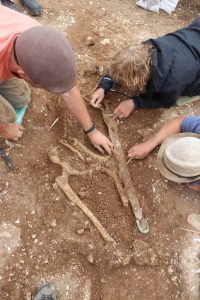In 2018 members of the detectorist group, the Maidenhead Search Society, identified the site of a high-status Anglo-Saxon warrior burial dating to the 6th century A.D. on a prominent site overlooking the Thames near Marlow. As responsible detectorists they contacted the Portable Antiquities Scheme who conducted a targeted excavation to recover a pair of bronze bowls (seen in the picture below) that had given the original signal. In the summer of 2020 team from the University of Reading led by Dr Gabor Thomas and assisted by local volunteers, returned to the site to conduct a more comprehensive excavation to better understand the nature and context of the burial. This resulted in the recovery of the skeletal remains – a male individual of around 40-50 years of tall stature with a robust physique – accompanied by an array of grave goods, including an exceptionally well-preserved iron sword in its original wood and leather scabbard.
The Marlow burial opens a window on the role played by the River Thames in the complex and fluid dynamics of kingdom formation in early historic England. The Marlow stretch of the Thames is traditionally regarded as a peripheral borderland contested by the powerful neighbouring kingdoms of Wessex, Mercia and Kent. Contrary to this image, this burial demonstrates that this region was the home of an autonomous tribal grouping ruled by powerful and well-connected warrior leaders.

Thanks to the generosity of those who supported our crowdfunding campaign, the skeletal remains and grave goods are currently undergoing a comprehensive programme of research, analysis and conservation. This will build a detailed picture of the Marlow warrior in his wider context and prepare the grave goods for display at Buckinghamshire museum as part of a new early medieval gallery opening in summer 2022.
A free copy of the Marlow Warlord ebooklet can be downloaded by clicking here
